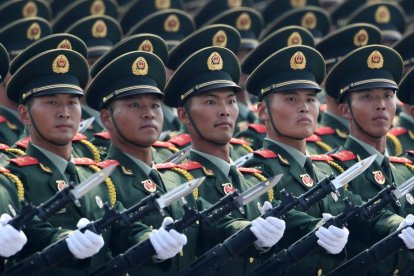China invests almost as much as the United States in defense
New reports confirm that China hides almost 70% of its military funding, which allegedly exceed $710 billion.

(Cordon Press)
China is close to catching up with the United States in military spending, per a recent report by the American Enterprise Institute, which corroborates information from American intelligence. According to these new estimates, China manages to hide about 70% of its true investment in defense. Its military spending is projected to be roughly $710 billion, almost as much as the United States' $742.2 billion.
Publicly, the Chinese government assures that its annual defense spending is around $226 billion. The United States has heavily questioned this figure. U.S. intelligence reports indicated that the total sum could be much higher. Guided by these reports, Congress members Mitt Rommey, Joe Manchin, Dan Sullivan and Angus King promoted a law to make the country aware of China's true investment in defense.
Mackenzie Eaglen, a senior analyst at the American Enterprise Institute, has been warning for several months about the full extent of the rise of military spending in China. At the end of April, Eaglen definitively estimated the real speed of China's rearmament, which is far from the data offered by the Chinese Communist Party. The main reasons are that Chinese funding of paramilitary apparatuses are not counted as pure investment in defense.
Lack of purchasing power parity
At the center of the issue is also a study applying a methodology that considers purchasing power parity and the gap that exists in this regard between the United States and China. That is, what the Chinese government can really achieve in China with its investment compared to what the American government acquires in the United States. This low-cost paradigm in China exponentially enhances the government's investment. Face value comparisons do not take into account the basic economic differences that allow China to get more bang for its buck. Simply converting Chinese yuan spending to U.S. dollars based on a currency exchange rate overstates U.S. capabilities if China pays significantly less for labor, wages, and products.
"The American public is too often at ease in believing the U.S. military remains ahead of all its competitors, with misleading statistics erroneously illustrating that the United States’ defense spending dwarfs that of the next 10 countries combined," says Mackenzie Eaglen's report.
China bolsters its military power
As the world's second-largest military power, China is a direct competitor of the United States on the geopolitical scene. This paradigm has been reinforced in recent years around the Pacific, where China struggles to grow its influence. The greatest example is the struggle for the so-called China Sea and for sovereignty over Taiwan.
The Department of Defense estimated in late 2023 that China had exponentially increased its military capabilities in recent years. China's military has historically focused on defense, with short and medium range mobilizations and with few deployment capabilities abroad. However, the growing investment in its navy and air assets concerned the Pentagon.
Can the United States keep up?
Given the increase in military spending by its direct geopolitical competitor, the United States must make decisions in accordance with the information reflected in Eaglen's report. The work of the American Enterprise Institute urges the U.S. intelligence community to share its findings on the scope and scale of China's military budget. "If the intelligence community is calculating military budget estimates for China that nearly equal America’s own, the American public and policymakers should be brought up to speed."
In this sense, Eaglen applauded the initiative of the congressmen and their bipartisan law for the Pentagon to prepare reports adjusted to reality and for them to be submitted to Congress and public opinion. For the senior analyst, policymakers should go a step further and encourage intelligence agencies to make their own estimates public, since the existence of competing estimates would greatly contribute to the debate about the severity of the Chinese military threat.
RECOMMENDATION





















